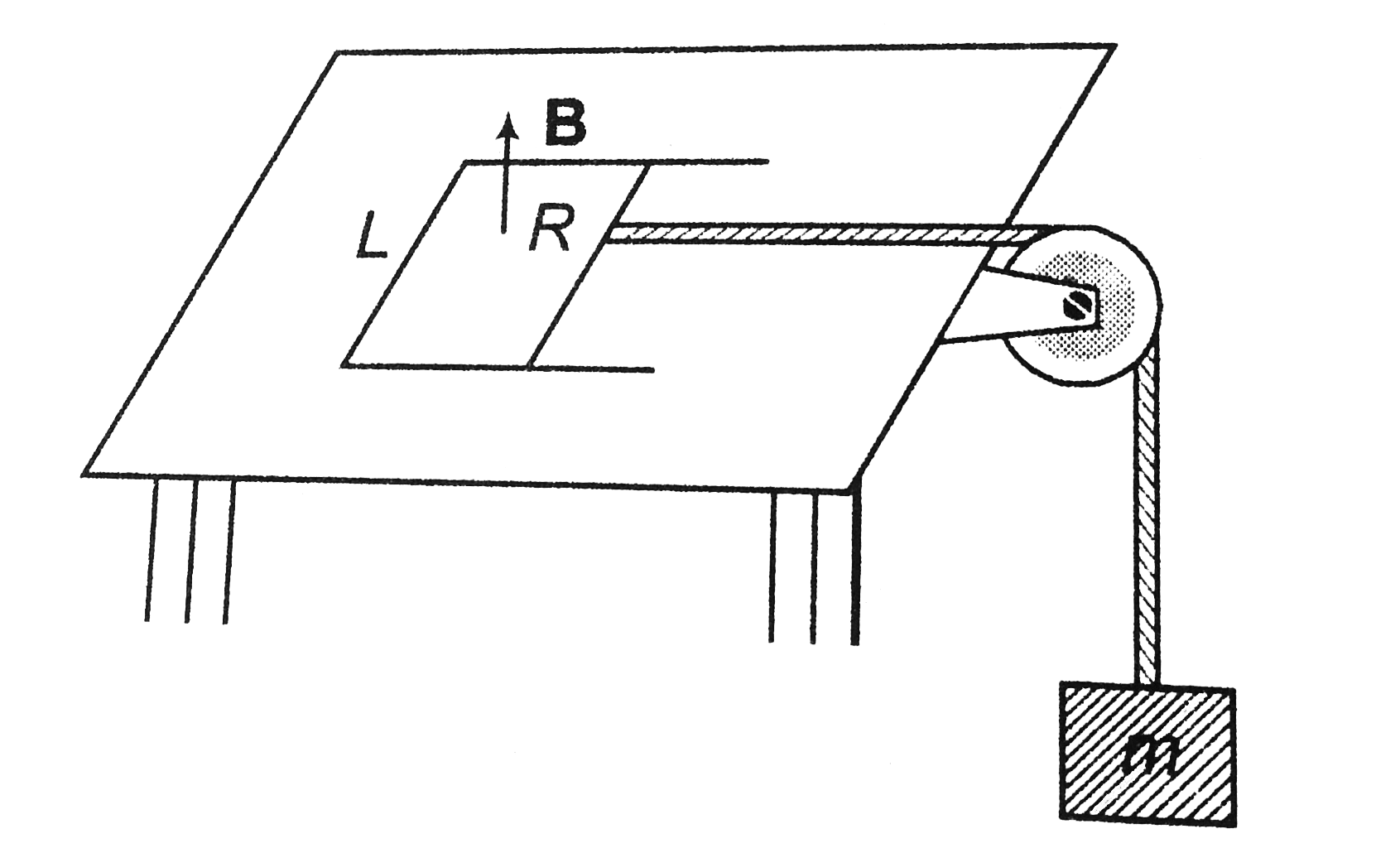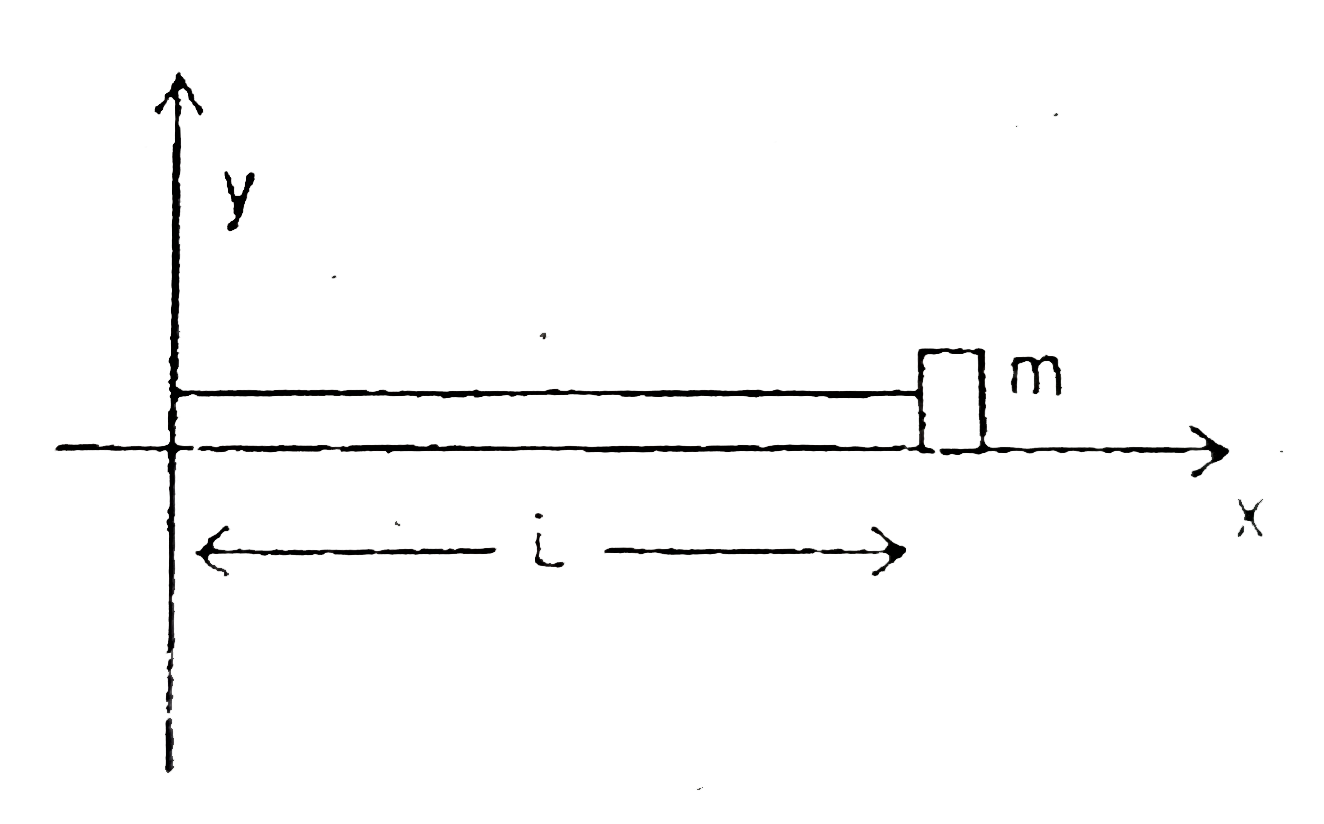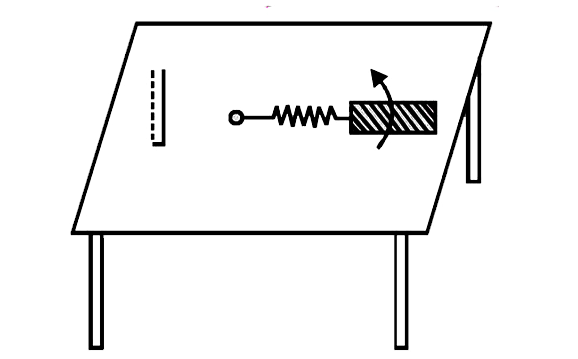A pair of parallel horizontal conducting ralls of negligible resistance shorted at one end is fixed on a smooth table. The distance between the ralls is L. A massless conducting rod of resistance R can slide on the rails frictionlessly. The rod is tied to a massless string which passes over a pulley fixed to another edge of the table. A mass m, tied to the other end of the string, hangs vertically. A constant magnetic field B exists along the perpendicular to the plane of the table in upward direction. If the system is released from rest, calculate [i] the terminal velocity of the rod, [ii] the acceleration of the mass at the instant, when the velocity of the rod is half the terminal velocity.
![A pair of parallel horizontal conducting ralls of negligible resistance shorted at one end is fixed on a smooth table. The distance between the ralls is L. A massless conducting rod of resistance R can slide on the rails frictionlessly. The rod is tied to a massless string which passes over a pulley fixed to another edge of the table. A mass m, tied to the other end of the string, hangs vertically. A constant magnetic field B exists along the perpendicular to the plane of the table in upward direction. If the system is released from rest, calculate [i] the terminal velocity of the rod, [ii] the acceleration of the mass at the instant, when the velocity of the rod is half the terminal velocity.](https://d10lpgp6xz60nq.cloudfront.net/physics_images/CHY_DMB_PHY_XII_P1_U04_C01_SLV_006_Q01.png)
Let, rod A'B' of length L and resistance R slide with a velocity v along y-axis, while a constant magnetic field B exists along z-direction.
Induced current flowing through the rod,
I=eR=BLvR
The direction of flow of the current through the rod A'B' will be such that, it opposes the cause of generation of induced emf i.e., the motion of the rod along positive y-axis. Thus the rod will experience force along negative y-axis. The magnitude of the force is given by,
F=BIL=B.BLvR.L=B2L2vR
Let the rod move with acceleration a, along positive y-axis. Then from the equation of motion,
ma=mg−F=mg−B2L2vRor,a=g−B2L2vmR
When the rod gets terminal velocity v0, then a = 0
∴0=g−B2L2v0mR
∴v0=mgRB2L2
When the rod moves with velocity, v=12v0, then
v=mgR2B2L2
Hence the acceleration of the mass at the instant,
a=g−B2L2mR.mgR2B2L2=g−0.5g=0.5g
Topper's Solved these Questions
- BOOK - CHHAYA PUBLICATIONCHAPTER - ELECTROMAGNETIC INDUCTION & ALTERNATING CURRENTEXERCISE - SECTION RELATED QUESTIONS29videos
ELECTROMAGNETIC INDUCTION & ALTERNATING CURRENT
- BOOK - CHHAYA PUBLICATIONCHAPTER - ELECTROMAGNETIC INDUCTION & ALTERNATING CURRENTEXERCISE - HOTS19videos
ELECTROMAGNETIC INDUCTION & ALTERNATING CURRENT
- BOOK - CHHAYA PUBLICATIONCHAPTER - ELECTRIC POTENTIAL EXERCISE - CBSE Scanner13videos
ELECTRIC POTENTIAL
- BOOK - CHHAYA PUBLICATIONCHAPTER - ELECTROMAGNETIC WAVES EXERCISE - CBSE SCANNER17videos
ELECTROMAGNETIC WAVES
Similar Questions
A pair of parallel horizontal conducting rails of negligible resistance shorted at one end is fixed on a table. The distance between the rails is L. A conducting massless rod of resistance R can slide on the rails frictionlessly. The rod is tied to a massless string which passes over a pulley fixed to the edge of the table, A mass m, tied to the other end of the string hanges vertically. A constant magnetic field B exists perpendicular to the table. If the system is released from rest, calculate.
(i) the terminal velocity achieved by the rod, and
the acceleration of the mass at the instant when the velocity of the rod is half the terminal velocity. View Solution
View SolutionA pair of parallel horizontal conducting rails of negligible resistance shorted at one end is fixed on a table. The distance between the rails is L. A conducting massless rod of resistance R can slide on the rails frictionlessly. The rod is tied to a massless string which passes over a pulley fixed to the edge of the table. A mass m tied to the other end of the string hangs vertically. A constant magnetic field B exists perpendicular to the table. If the system is released from rest, calculate

a. the terminal velocity achieved by the rod and
b. The acceleration of the mass of the instant when the velocity of the rod is half the terminal velocity.View Solution
Knowledge Check
- Question 1 - Select One
Two bodies of masses 4 kg and 6 kg are tied to the ends of a massless string. The string passes over a frictionless pulley. The acceleration of the system is :
Ag2Bg3Cg5Dg10 - Question 2 - Select One
A block of mass m1 rests on a horizontal table. A string tied to the block is passed on a frictionless pulley fixed at the end of the table and to the other end of string is hung another block of mass m2. The acceleration of the system is
Am2gm1+m2Bm1gm1+m2CgDm2gm1 - Question 3 - Select One
A pair of long, smooth, parallel, horizontal, conducting rails are joined to a cell at one end. There are no external electric or magnetic fields. A metal rod is placed on the rails. The rod will
Aremain stationaryBmove towards the cellCmove away from the cellDoscillate
A pair of parallel horizontal conducting rails of negligible resistance shorted at one end is fixed on a table. The distance between the rails is L. A conducting massless rod of resistance R can slide on the rails frictionlessly. The rod is tied to a massless string which passes over a pulley fixed to the edge of the table. A mass m tied to the other end of the string hangs vertically. A constant magnetic field B exists perpendicular to the table. If the system is released from rest, calculate

a. the terminal velocity achieved by the rod and
b. The acceleration of the mass of the instant when the velocity of the rod is half the terminal velocity.View SolutionTwo bodies of masses 4 kg and 6 kg are tied to the ends of a massless string. The string passes over a frictionless pulley. The acceleration of the system is :
View SolutionA block of mass m is tied to a string of length L and the assembly is kept on a smooth horizontal table as shown in the figure. Now the other end of the string is moved with a constant velocity v0ˆj. (xy plane is the plane of the table) Then
 View Solution
View SolutionA block of mass m1 rests on a horizontal table. A string tied to the block is passed on a frictionless pulley fixed at the end of the table and to the other end of string is hung another block of mass m2. The acceleration of the system is
View SolutionA metallic rod of length 'l' is tied to a string of length 2l and made to rotate with angular speed w on a horizontal table with one end of the string fixed. If there is a vertical magnetic field 'B' in the region, the e.m.f. Induced across the ends of the rod is
 View Solution
View Solution

